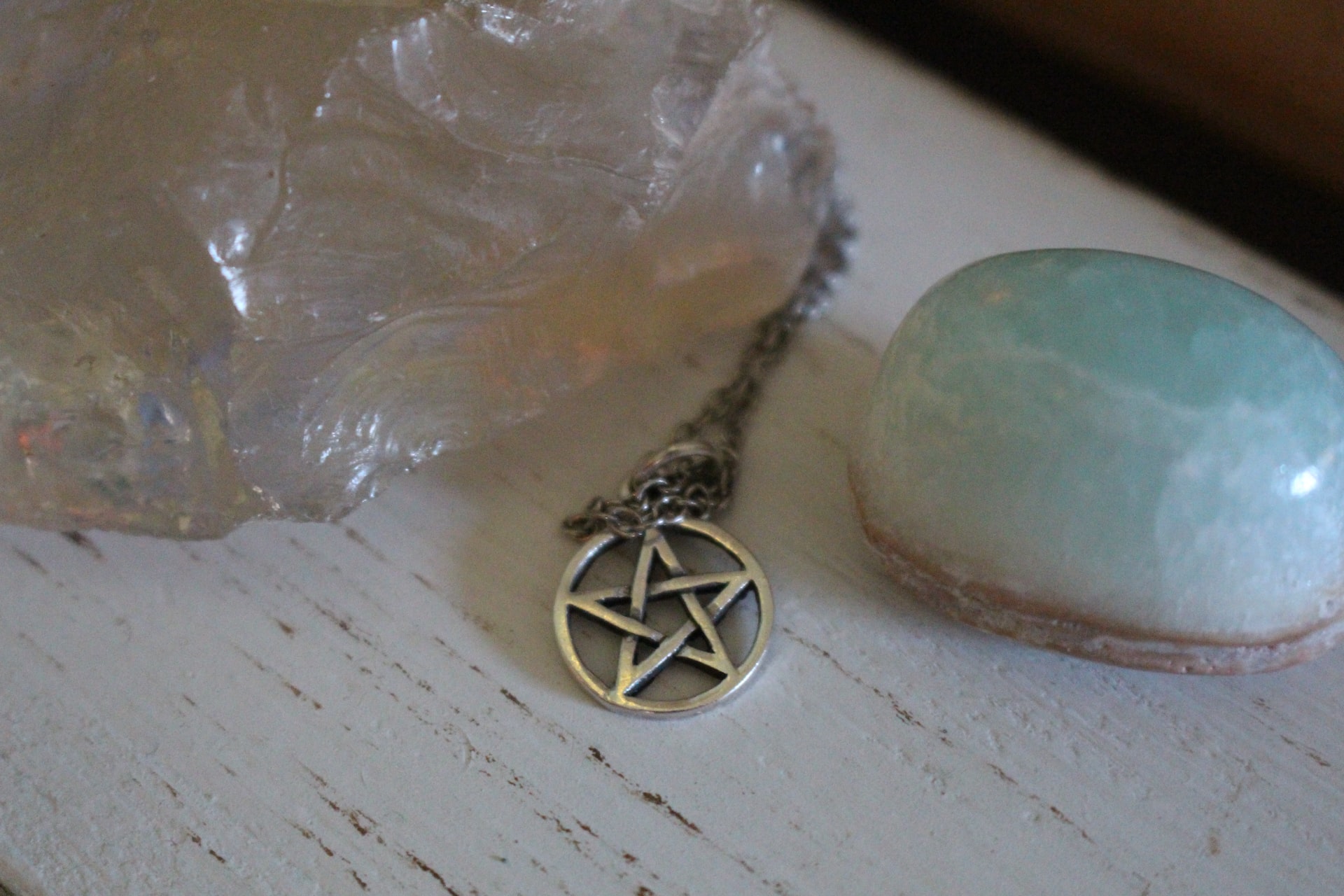Before Laurie Cabot was the “Official Witch of Salem”, there was Sybil Leek, “Britain’s most famous witch”. Sybil Fawcett Leek (1917-1982) was called “Dame Sybil” by some and “That Damn Sybil” by others. A colorful character by any stretch of the imagination, she was a Witch, psychic, and occultist. She grew up in the New Forest area – the same area where Gerald Gardner found the coven that initiated him into the Craft in 1939. Over her lifetime, she wrote dozens of books on astrology, numerology, reincarnation, and other occult topics, but she is best known for her sensational autobiography, Diary of a Witch, published in 1969. In it she claims hereditary connection to the occult from both sides of the family, as well as through friendship with the Romani – she uses the outdated term Gypsy – people in the New Forest.
Sybil lived as an out Witch, which caused her difficulties as the years went by. Eventually her landlord refused to renew her lease and she was forced to move out of the area. She chose to leave England and live instead in the United States, where she continued to promote the Craft as the Old Religion of Europe. She became a celebrated astrologer, celebrity, and author, and she continued to practice the Craft until her death from cancer.
Sybil differed from Gerald Gardner in her opinions on malicious magick, among other things. Gerald held that the highest duty of a Witch was to harm none, whereas Sybil believed that cursing was the prerogative of each individual practitioner. She certainly had a point; the practice of using Witchcraft for cursing is more than adequately attested to in the historical record. But she didn’t seem to capitalize on curses other than writing a book on the topic. Some of her other strongly held opinions, such as disapproving of ritual nudity, would later become woven into the fabric of modern Paganism.
Depending on who you asked, even in her later years, people weren’t sure whether Sybil’s Witchcraft was a joke or a scam or a brave new way of living. But she certainly left her mark on both the Neopagan world as well as mainstream culture.
The Six Tenets of Witchcraft
Sybil’s book The Complete Art of Witchcraft (1973) outlined what she called the Tenets of Witchcraft. Some traditions of Wicca have adopted these Tenets, sometimes misattributing them to other people. When I was studying under Taz Chance, we were challenged to memorize the six concepts – and if you got stuck and couldn’t remember one, Taz told me, then that was the one you needed more of in your life! I present them here more as guidelines rather than actual rules, to paraphrase a famous live-action Disney franchise, with my interpretations based on how I came to understand them in my life and practice.
Balance
We all need balance in our lives. But that balance is going to look different for each person. I found that I was more balanced in my mundane life when I integrated my spiritual life into it instead of keeping them mentally separate. I no longer “put on my witchy hat” just for rituals and community outreach. I’ve found that embracing the spiritual aspect of my life has made my mundane life more magickal, more fulfilling, and honestly more exciting. It’s also given me the opportunity to look at my physical and mental health as part of my spiritual health. When I was unbalanced, I would either totally ignore the Craft and run myself into the ground trying to cultivate the perfect life or I would totally absorb myself in the Craft and run myself into the ground trying to cultivate the perfect witchsona, all the while ignoring basics like laundry and dishes. When I looked at my physical, mental, and spiritual lives as integrated, I could begin to see where I was truly out of balance and take steps to adjust my priorities and reinforce my boundaries.
Harmony
Harmony is what happens when everyone does their part and it all comes together in a beautiful way. It’s true in music, in magick, and in life. Harmony cultivates a peaceful and pleasant environment filled with mutual understanding and affirmation. Think of it as hygge for the soul. Harmony reminds us to embrace the differences in our paths because we’re all working toward the same goal and weaving a beautiful tapestry of life while we do so. I’m a “both-and” or a “win-win” kind of person, and I truly believe that there are ways for conflict to be resolved through negotiation and compromise, bringing opposing sides into the harmony of alliance. In my spiritual life, I look to this tenet to help me build a rich and affirming culture in my coven and tradition. In my mundane life, I look to this tenet to navigate both workplace politics and all the citizen activism I do.
Humility
In the Craft, we need to have an ego the size of all outdoors to think that we can bend the universe to our will. We also need to have the humility of a monastic to understand that we are nothing more than cells in the body of the Goddess. We are mighty and powerful and unique, and we are also insignificant and inconsequential. Our individual actions, while important to us and those close to us, are overwhelmingly trivial in the eyes of the universe. This dichotomy is at the heart of humility. It protects us from getting “too big for our britches” and grants us a freedom that we simply don’t have if we’re constantly put on a pedestal. I’ve found a great deal of peace in being humble. It has given me the freedom to step off that pedestal, to free myself from worries about what I “should” do – because nobody likes to be “should” upon – and embrace what I can and want to do. Humility has also given me the freedom to have strong boundaries when it comes to my capabilities. I am only human. I cannot be all things to all people, and I cannot do it all or all by myself. So, rather than be a self-effacing doormat who runs themselves into the ground trying to be all things to all people, I have learned the powerful magick of the word “no” to keep me truly humble.
Knowledge
Knowledge is more than what you read in books. It’s what you experience. It’s what comes together for you in an “a-ha!” moment. It’s what you observe and file away for future reference. More than one wise teacher has told me that if we stop learning, we stop living. One of the ways I’m trying to apply this to my own practice is to keep up-to-date on the new books coming out by Pagan authors. The books these days are of so much higher quality than the ones in the 1990s and early 2000s. Even the “Wicca 101” introductory books are so much richer in content than RavenWolf and Cunningham were. And I’m not knocking Raven or Scott here – they are the building blocks on which many Pagan authors built their own practice. But we’ve learned and grown in the twenty to thirty years since Teen Witch and Wicca: A Guide for the Solitary Practitioner first hit shelves. Some assumptions have been questioned, explored, and ultimately replaced with something that makes more sense for an earth-based mystery religion. So I implore you to read the new stuff coming out now, visit the authors’ blogs, subscribe to their Patreons, and get out of your comfort zone. It will take you far and benefit your practice.
Tolerance
The thing about tolerance is that in order to have a community that embraces a wide variety of opinions and experiences, that community must not embrace hateful opinions and beliefs. And that’s a delicate balance. It starts with the individual. If you are a White American, you must come to realize that you are racist. It doesn’t matter how many friends of color you have. You have been warped into racist thinking from the cradle because of the systemic racism ingrained in America’s very essence. You must actively work to become anti-racist. And as you do this, you’ll come to understand your own prejudices and have the opportunity to lay them to rest. Tolerance also extends to battling homophobia, transphobia, misogyny, misandry, political differences, religious differences, and differences of ability. Of all of the tenets, I feel like this one is the most difficult to strive for because it calls for more than a little bit of shadow work to achieve. It was challenging for me – and still is because this work takes a lifetime to complete – to accept that the “don’t see color” attitude I was raised with caused me to ignore whole swaths of my friends’ experiences. When I began to see color, I was endarkened to the reality of The Struggle. When I realized I was nonbinary, I came to understand my prejudices against trans people. When I acknowledged the depth of trauma I suffered after being raped, I began to see how that affected my relationship with men. And all of that opened up many opportunities to learn better, do better, teach better, and grow as a person and a Witch.
Trust
Trust is the beginning of faith. We trust our friends to be there for us when they can. We trust ourselves to make good decisions. We trust the Gods to guide and protect us. We also need to trust people to be who they are – if someone is two-faced, we need to trust them to continue to be that way. If someone is unreliable, we need to trust that that isn’t going to change overnight. It’s not about judging them. It’s about accepting them for who they are even as we have faith that they will grow into who they could be. Trust requires us to be informed and observant; it also requires us to let that seed of faith grow where there is fertile ground.

